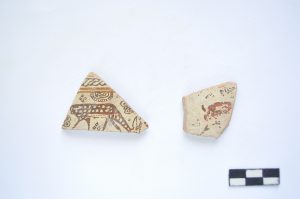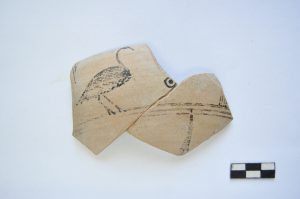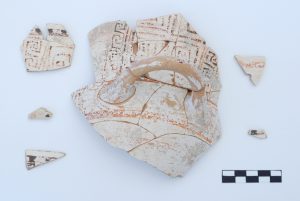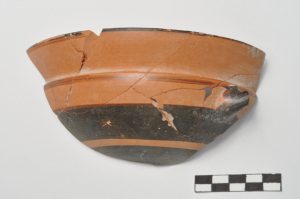One of the most popular categories of imported pottery in Karabournaki is that which originates from pottery workshops located in Eastern Greece. These vases are quite common during the 7th and 6th BC, a time when the area of Ionia was experiencing great economic growth. The earliest samples of Eastern Greek pottery in Karabournaki can be dated to the end of the 8th c. BC, and probably reached the settlement as individual products and not in the context of systematic trade with this region. These early specimens are post-geometric and sub-geometric vessels, mainly kraters and dinoi, with a few examples of “bird” cups.

However, since the beginning of the 7th c. BC, the pottery imports from the workshops of Eastern Greece increase significantly and become regular. This influx seems to have continued uninterrupted throughout the 6th century. B.C. The banqueting vessels are the ones that dominate, with the drinking vessels being numerically superior, followed by oinochai, fruit bowls and plates. In summary, the vessels found in the toumba at Karabournaki can be divided into the following categories:
- Wild Goat Style vases
This is a popular category of pottery, which owes its name to the decoration on the vessels. This decoration consisted of friezes of animals (usually goats) on an off-white background. The most common shapes of this category were oinochai and fruit bowls.

- Bird bowlsThese vases are a development of an older type of vase, the geometric bird kotyle, and were produced from the Late Geometric period up to the entire 7th c. BC. Their characteristic feature is the decorative motif with a bird rendered with the border technique. The dating of the speciments found in Karabournaki covers the entire era of production of this category.

- Chian chalices
Chian chalices, along with chian amphorae, are products of the ceramic workshops of Chios and are often found in the northern Greece area. They present common constructional characteristics, such as the brown-red clay and the white coating. Chian chalices are drinking vessels, with painted decoration with geometric patterns. Most of the chian chalices found in Karabournaki can be dated to the 6th century BC.

- Ionic cups
“Ionic” cups are a class of vases widely spread throughout the Mediterranean, originating from the wider region of Eastern Greece. For this reason, the term “Ionic” does not fully correspond to their origin and is a conventional term. These vases, due to their wide spread, were often imitated by local ceramic workshops. This is the most common category of pottery in Eastern Greece found throughout the excavated area of the ancient settlement in Karabournaki, covering the most representative types of the category.

- Ionic “bucchero”
Although they are not a large group among the finds of the toumba settlement, they are particularly characteristic because of their gray clay. Perfume containers, like aryballoi and alabastra, are the main shapes produced, along with a few other types. This type of pottery mainly appears during the second half of the 7th and the first half of the 6th c. BC.

These categories of pottery are found throughout the area of the settlement and it seems that they are products of commerce. The presence of this pottery, in combination with the commercial amphorae and the rest of the imported categories found in the excavation, show the significance of the settlement as an important commercial station. In addition to the other nearby settlements that were accommodated by the port, it is possible that the port also functioned as a station on the course of certain commercial routes in the Northern Aegean.
